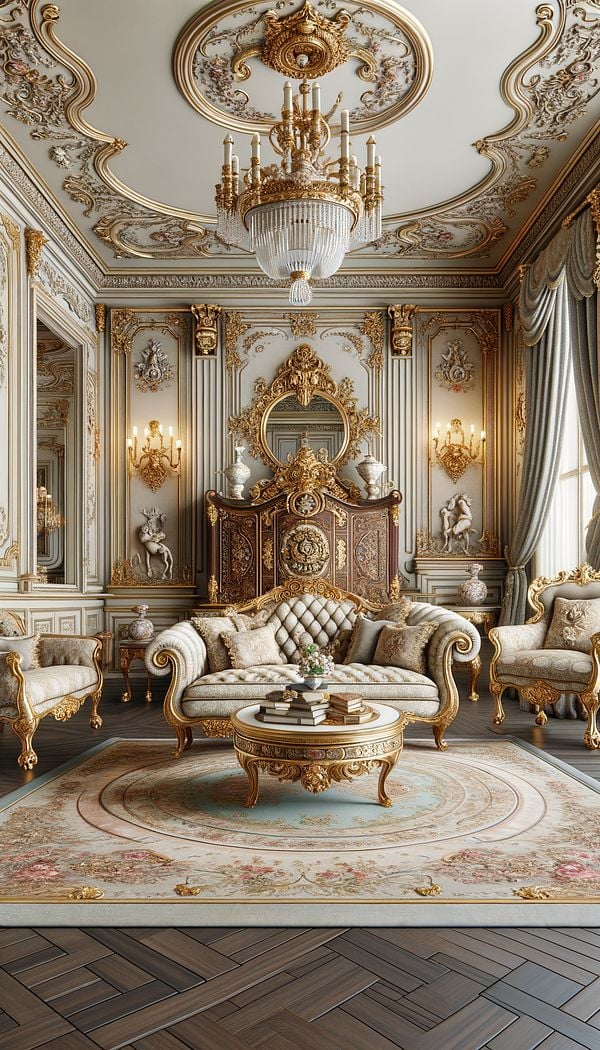What is French Regence?
French Regence is a decorative style of interior design developed in France between 1715 and 1723.
Description
French Regence, or Régence in its French spelling, is a decorative style that flourished in the early 18th century, serving as a transition between the magnificent grandeur of the Louis XIV style and the lighter, more delicate designs of the Rococo period. This style emerged during the regency of Philippe d'Orléans, who ruled France as the regent for the young Louis XV from 1715 to 1723. The French Regence style is characterized by an increased emphasis on comfort and an overall lighter approach to decoration and furniture design compared to the preceding era.
This period saw the introduction of new furniture forms, such as the canapé (a type of sofa), the commode (a low cabinet or chest of drawers), and smaller, more portable tables. It also incorporated more organic shapes in architectural elements, with fluid curves and less symmetry, reflecting the beginnings of the Rococo movement. Decorative motifs often included shells, scrolls, and plant forms. The use of gilt-bronze, or ormolu, for furniture mounts and decoration became increasingly popular, adding a sense of luxury and opulence.
As the style developed, interiors became more intimate and ornamental, focusing on user comfort and incorporating a wide range of materials, including exotic woods, lacquer, and textiles. The French Regence style played a significant role in the evolution of European decorative arts, influencing the design of furniture, interiors, and architecture well into the Rococo period and beyond.
Usage
The French Regence style is often used in designing and decorating high-end residences, boutique hotels, and spaces that aim to evoke an aura of elegance from the early 18th century. It can be found in the choice of furniture, the design of lighting fixtures, and the use of decorative motifs that are reflective of the period.
FAQs
-
What distinguishes French Regence style from other periods?
French Regence is distinguished by its lighter, more comfortable approach to design, the introduction of new furniture forms like the canapé and commode, and its organic, less symmetrical shapes. It marks a transition from the grandeur of Louis XIV style to the delicate Rococo aesthetic.
-
How can I incorporate French Regence style in a modern home?
Incorporate curved furniture pieces, use luxurious materials, add gold or gilt accents, and include decorative items with organic motifs. Aim for elegance balanced with comfort and intimacy.
-
What are some key furniture pieces in French Regence style?
Key pieces include the canapé, a type of sofa; the commode, a low chest of drawers; and various small, portable tables. These pieces often feature organic shapes and ornate decorations.
-
What materials are commonly used in French Regence style interiors?
Common materials include exotic woods, lacquer, gilt-bronze or ormolu for furniture mounts, and luxurious textiles.
-
How did French Regence style influence later design movements?
French Regence played a crucial role in the evolution of European decorative arts, bridging the gap between the Louis XIV style and Rococo. Its emphasis on comfort, lighter decoration, and organic shapes influenced the design of furniture and interiors well into the subsequent periods.
Practical Application
To apply the French Regence style in modern interiors, focus on incorporating elegant, curved furniture pieces and decorative items with organic motifs. Choose soft, luxurious materials and add touches of gold or gilt accents for a sense of grandeur. The key is to balance the decorative elements with a sense of comfort and intimacy, embracing the style's emphasis on livability.
-
Design Styles478 articles
-
Furniture Types599 articles
-
Decorative Techniques322 articles
-
Historical Periods & Movements150 articles
-
Materials & Textiles360 articles
-
Counter StoolA counter stool is a tall, narrow chair designed for use at a kitchen counter or bar.
-
GeometricGeometric refers to the use of shapes, lines, and forms in design.
-
Tuckaway TableA tuckaway table is a space-saving furniture piece designed to be easily folded or collapsed for storage.
-
AcetateAcetate is a synthetic, semi-synthetic fiber used widely in interior design for its versatility and aesthetic appeal.
-
Beveled EdgeA beveled edge refers to an edge of a structure that is not perpendicular to the faces of the piece.
